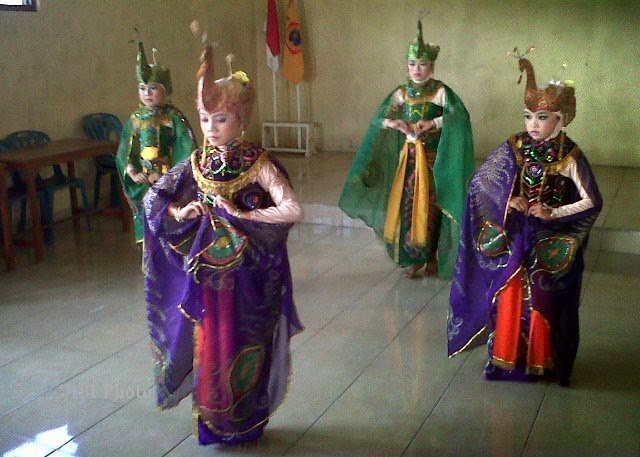This time I discuss about the traditional dance of Java rate:
1. Tari Gambyong
The art of dance is derived from Surakarta, Central Java. Beginning of term Gambyong originated from the name of a dancer named taledhek Gambyong a contemporary Sunan Pakubuwana IV in Surakarta. Ledhek dancer named Gambyong have proficiency in dancing and sonority in the sound so that it becomes the idol of the young people of that era. Taledhek term is also used to refer to the dancers tayub, taledhek dancers, and dancers gambyong.
Characteristic Dance performances Gambyong, before starting is always opened with the piece Pangkur. The dancing looks beautiful and elegant when the dancer is able to sync motion to the rhythm of drums. Direction eyes moving to follow the direction of motion of the hand with regard fingers, making the dominant factor in the hand motions eksGambyong can also be interpreted as a solo dance performed by a woman or a dance performed to the beginning of the dance performances or dance party. Gambyongan have the meanings depicts a woman dancing in the puppet show as a cover. presi Gambyong dance. Footwork at the time of embryo and walking posture correlate harmony.
2. Tari Bondan Payung
Bondan dance is a dance which originated from Surakarta, Central Java. This dance symbolizes a mother who keep their children with care.
Tari Bondan divided into three, namely:
1. Bondan Cindogo
2. Bondan Mardisiwi
3. Bondan Mountains / Farmer
Bondan dance is part of the classical dance is a dance of joy. This dance expresses compassion of a mother to newborn son. On the dance Bondan Cindogo tucked sad story in which the only child cuddled-buckle eventually died, while at Bondan Mardisiwi not. Bondan dance supplies Mardisiwi often without using kendhi as on Bondan Cindogo.
Feature dance: namely dressed like a country girl, carrying a basket, wearing a hat and carrying farm tools. The first dance form depicts the lives of farmers and then clothes depicting the exterior of the mountains girls removed one by one with his back to the audience. Furthermore dancing like dance Bondan Cindogo or Mardisiwi.
3. Tari Remog
Tari remong a welcome dance typical of East Java that describe the dynamic character of East Java. Regions that use these dances include Surabaya, Jombang, Malang, and Situbondo. This dance is packaged as an illustration of the courage of a prince who fought in a battle field. Hence the much needed masculinity dancers in this dance performance. Tahun1900 promoted dance around this, once used by Indonesian nationalists to communicate to the public.
The most important characteristics A of Tari Remo is a smart footwork and dynamic. This movement is supported by the bells were installed in the ankle. This bell sound when the dancers move or stomping on the stage. In addition, other characteristics A shawl or sampur the movement, the movement of a nod and a shake of the head, facial expressions, and horse-riding dance dancer make this more attractive. SANDALS
Clothing of dancers Remo there are various kinds of styles, including: Style Sawunggaling, Surabayan, Malangan, and Jombangan. There are also the typical fashion wear for women Remo Dance style.
Consisting of red headbands, clothes without buttons are black with royal style in the 18th century, the extent of the mid-calf pants are crocheted with gold needles, gloves coastal batik that hung down to his knees, waistband tied at the waist, and slipped a dagger rear. Dancers wore two scarves, which one worn at the waist and the other pinned at the shoulder, with each dancer holding hand of each end of the scarf. In addition, there is also a collection of anklet bells are looped around the ankle.
Tari Remo music that accompanies it is gamelan, which usually consists of bonang barung / BABOK, bonang successor, saron, xylophone, gender, slentem zither, flute, kethuk, kenong, kempul, and gongs. The type of rhythm that is often sung to accompany Tari Remo is Jula-July and Tropongan, but can also be gending Walangkekek, Gedok Rancak, Krucilan or gending new creations. In ludruk performances, dancers usually insert a song in the middle of the dance.

















































.jpg)









Follow Us